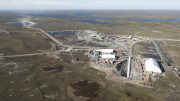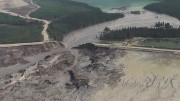If you thought around mid-year that the iron-ore market couldn’t get any worse, September was a bit of a shocker.
Now plumbing depths of US$80 per tonne, iron-ore prices have fallen to five-year lows — levels not seen since September 2009, in the full sway of the Great Recession.
Just this year, iron-ore prices are down an astonishing 40%.
U.S. brokerage house Cowen and Co. notes in a report that “adding to the pricing pressure is the fact that Chinese crude steel consumption dropped 0.3% to 500MM tonnes in the first eight months of 2014, marking the first time Chinese steel demand has fallen since 2000.”
Cowen reports that BHP Billiton’s view is that the decline “reflects the reality of demand and supply in the market for iron ore and is not bullish on a significant recovery in the price of iron ore,” and that vice-chairman of the China Iron and Steel Association Wang Xiaoqi stated at an industry conference that China’s domestic steel output and consumption “won’t rise along with economic growth, and that iron-ore supply exceeded demand in China by 81MM tonnes from January to August.”
Mining-oriented brokerage firms such as London-based Investec Securities go so far as to say that “the commodity super-cycle is officially over, as confirmed by the current crash in iron-ore prices.”
During the upswing of the last decade, Investec argues, “the mining industry appears to have forgotten all the ‘sins of the past’ and as a result invested huge amounts of capital, effectively ensuring oversupply of iron ore for the foreseeable future, with consequent price weakness. Arguably this is precisely what the major importers of iron ore wanted and actively encouraged.”
And Investec sees no relief ahead: “We feel the weakness in iron-ore pricing is here to stay and that the market has not yet realized the magnitude and effect of such sustained price weakness.”
In hard numbers, Investec shows that the majors plan on introducing 80 million to 120 million tonnes of new supply each year over the next four years, or a total of 400 million tonnes of additional supply by 2018.
“Meanwhile, projects which are not owned by the majors, but that are fully financed, are expected to add an additional 130 million tonnes each year of incremental production over the same period, taking total additional supply to 530 million tonnes per year. In order to consume this new supply, demand for seaborne product would have to grow at an annual rate of 7.5% from 2013 levels of 1,210 million tonnes — an outcome that is increasingly unlikely, as Chinese steel-demand growth falters.”
Looking ahead in the near-term, Investec argues that the lowest-cost producers, Rio Tinto and BHP Billiton, “have the margins to prevail, but it appears that this will be trench warfare rather than a decisive battle. As such we now expect an extended period of depressed prices, with prices only picking up modestly once high-cost producers are eventually driven out.”
Following that logic, look in the months ahead for a wave of closures of high-cost iron ore mines worldwide, and a shelving of any kind of iron ore mine construction or expansion program, or exploration effort.
All is not lost, though, Investec argues, and its favoured commodities remain copper and diamonds “due to a copper market that is expected to remain balanced in the next few years, and hence remain vulnerable to supply side shocks, and rising diamond prices due to under-investment in the industry and rapidly increasing demand from China.”




Be the first to comment on "Editorial: Iron ore prices – grim and grimmer"